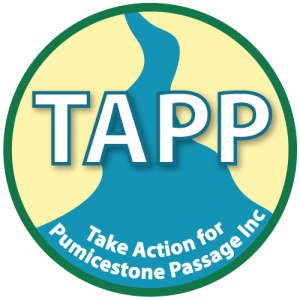WORKSHOP NOTES ON SUSTAINABLE DEVELOPMENT:
What Don’t We Know?
- Do we know the value of recreation, tourism, agriculture and ecosystem services to the catchment and the Inter-Urban Break?
- How should we manage damage to recreational values from jet skis, unsociable behaviour and vehicles? Through legislative change ensuring more state responsibility for compliance.
- What options are there for better management, for example with forestry leases?
- How can unsustainable development by prevented in the catchment?
- How can climate change be better incorporated into statutory documents? Eg. Planning scheme, , SEQRP 2017 – Urban Footprint.
- When and how will the carrying capacity of the catchment be determined?
- Co-ordinated approach to community and citizen science, data and integration, particularly for monitoring coastal zones and good quality monitoring guidelines. Need more education on the purpose and the how-to of data collection. How can schools be included more to affect parents?
- Knowledge and policy gap in environmental information and developers requirements.
- Co-benefits between nature and people- priority investment needed for planning, protection and conservation.
- Integrating Traditional Owners and Western knowledge systems.
- How does an individual invest in sustainable development in the region?
- Property market needs to make buyers aware of the future impacts of climate change on their property.
Actions:
- Green infrastructure audits and benchmarks for urban and rural residential development to maintain multiple objectives.
- Vehicle for investments in Sustainable Development
- Adopt rivers/creeks
- Document historic impacts on catchment (ie. Clearing of coastal Blackbutt by spraying, oyster dredging, loss of Bribie Wildflower habitat)
- Better coordination between the two local governments and State, for rehabilitation of rivers and watercourses.
- Buffer zones to coastal areas – to counteract sea level rise.
- Integrate PP Action Plan into Local Government Planning Scheme Codes.
- Development approvals must consider off site impacts such as stormwater from rainfall events.
- Definition of sustainable to include intergenerational equity.
- Circular economies for development, agriculture, tourism. (For example, odd bod markets for irregular shaped produce) – opportunities to value add to these economies.
- Decouple the growth based economy versus the sustainable economy.
What knowledge is needed?
Area 1 (northern):
- Impacts of current and further development (cumulative) eg. Erosion, tourism, domestic animals, recreational use etc.
- Current and future impacts of climate change
- Condition of marine and wetland ecosystems and effectiveness of restoration projects.
Area 2 (southern):
- How is research information (USC) being used in the renewal/review of Moreton Bay Marine Park Zoning review?
Area 3 & 4 (Bribie Island):
- Research into impact of Bribie fires on small mammal species population and ecology.
- Impacts of fire regime on vegetation type, composition of tree communities, and regeneration.
- Impacts of noise pollution at Sandstone Point on nearby bird populations.
- Aerial control of mosquitoes.
Area 5:
- Impacts of development (hydrology, runoff) in this area to other parts of the catchment.
- Research into the water cycle of Pumicestone Passage
Area 6:
- Impacts on ecological values of Pumicestone Passage as a result of the increasing development (particularly water quality).
Area 7
- Socio-economic characteristics of regions and implications of Maslow’s Hierarchy of Needs.
Key Issues:
- No further extension of urban development (southern)
- All boats require propeller guards
- Different authority areas need to be integrated.
- Better resourcing of policing throughout lower Pumicestone.
- Policing of feral dogs, cats, pets and animals on Bribie Island.
- Potential of groundwater extraction at Bribie Island.
- Seasonal closure of shorebird roosting areas.
- No north-south connection.
- Contain urban development to Caloundra South.
- Ongoing maintenance of WSUD elements – who pays?
- Water supply competition/issues
- Integrated resource management
- Using collaboration to improve farming practices and productivity.
- Further fragmentation of Area 7.
2050 Vision:
- Electric cars and boats
- No helicopters
- Algae water recycling
- Bioenergy resources
- Public transport throughout the region
- Precision farming agriculture
- Local manufacturing
- Closed loop waste cycle
- Areas of Native Title appropriately recognised
- Indigenous Land Management
- Everyone a citizen scientist
- Total water cycle management
- Continued RAMSAR status
- Shorebird populations returned to pre-development levels
- Healthy dugong populations
- More oyster reef restorations
- Returned oyster populations
- Predominantly natural environment and amenity.
